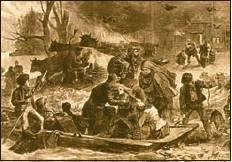This was America’s deadliest fire
We were all horrified recently when fire extensively damaged historic Notre Dame Cathedral in Paris. Fortunately, nobody died in that blaze. It was a much different story with the biggest and …
This item is available in full to subscribers.
Subscribe to continue reading. Already a subscriber? Sign in
Get 50% of all subscriptions for a limited time. Subscribe today.
Please log in to continueNeed an account?
|
This was America’s deadliest fire
We were all horrified recently when fire extensively damaged historic Notre Dame Cathedral in Paris. Fortunately, nobody died in that blaze. It was a much different story with the biggest and deadliest fire in American history. Chances are you’ve never even heard of it. That’s because it happened the same day as the Great Chicago Fire and was lost amid its headlines. But it was equally horrifying.
This is the tale of the Peshtigo Fire.
The first days of autumn 1871 were blisteringly hot in Wisconsin, Michigan and Illinois. Houses, stores, and barns built of wood (the predominant building material) and trees in nearby woodlands were bone dry. Back then, crews cleared forests for farms and railroads by starting small fires. Given the parched conditions that year, the woods and countryside were highly combustible. All that was necessary for a massive tragedy was a bad break from nature.
And nature obliged on Sunday, October 8.
A cold front roared through the region that day, unleashing dry winds as strong as 110 miles-per-hour. They spread flames far and wide and turned forests into infernos. The merciless winds made the fire feed on itself, unleashing natural versions of nuclear explosions and triggering firestorms.
It was literally Hell on Earth. Temperatures shot up to 2,000 degrees Fahrenheit and higher. Glass melted. The fury was so intense, witnesses recalled seeing fire tornadoes. The blaze spread so rapidly there was almost no escaping it. The moment it appeared people had seconds to jump into ponds, wells, or rivers. Those who couldn’t were instantly incinerated.
The flames jumped Wisconsin’s Peshtigo River, consuming everything on both banks. Smoke was so thick, nearby Green Island Lighthouse stayed lit all day and night to help people see.
In the town of Robinsonville, dozens of people huddled praying inside a small Catholic chapel. Although flames completely surrounded it, the building was somehow spared. Survivors called it a miracle and the church later became the National Shrine of Our Lady of Good Hope.
When the fire eventually burned itself out, authorities traipsed through the charred landscape and tallied the destruction. Up to 1,875 square miles were ruined, more than 1.2 million acres and over twice the size of Rhode Island. It’s impossible to know just how many people perished. The best estimate is between 1,200 and 1,500; the actual number may have reached 2,500. A cemetery in the town of Pesthigo holds the mass grave of 350 victims who couldn’t be identified.
There were other deadly blazes that same day. As I wrote earlier, as many as 300 people were killed and 100,000 left homeless by the Great Chicago Fire. On the other side of Lakes Michigan and Huron the towns of Holland, Port Huron, and Manistee all experienced deadly fires.
But the Peshtigo Fire’s horrific firestorms were the worst of the bunch. They were so bad, the U.S. military studied them during World War II and used information gleaned from them to develop the extremely destructive fire bombings of Dresden, Germany and Tokyo.
There was a theory, first promoted in the 1880s and resurrected during our lifetime, that burning fragments from the Comet Biela were responsible for such a widespread outbreak of massive fires on a single day. But science dismisses that suggestion. (It’s said there’s no documented case of a meteorite ever sparking a fire on Earth.)
As long as there are forests and hot, dry weather conditions there will always be wildfires. There’s no way to totally prevent them. But we have learned much since 1871. When the weather turns threatening outdoor burning bans are imposed. And modern technology makes it possible to contain major fires more quickly.
Few people visit Wisconsin’s little Peshtigo Fire Museum. Those who do see a small charred Bible that survived the nightmare. It’s open to Psalm 107, which says “… they drew near to the gates of Death. Then they cried out to the Lord in their trouble and He saved them out of their distresses.”
Have comments, questions or suggestions you’d like to share with Mark? Message him at jmp.press@gmail.com.
Other items that may interest you










Comments
No comments on this item Please log in to comment by clicking here